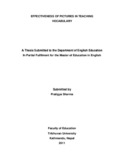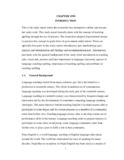Please use this identifier to cite or link to this item:
https://elibrary.tucl.edu.np/handle/123456789/925| Title: | Effectiveness of Pictures in Teaching Vocabulary |
| Authors: | Sharma, Pratigya |
| Keywords: | Teaching Vocabulary;language classroom;Teaching Aids;Visual Aids |
| Issue Date: | 2011 |
| Publisher: | Department of Education English |
| Institute Name: | Central Department of Education |
| Level: | Masters |
| Abstract: | The present study entitled “Effectiveness of Pictures in Teaching Vocabulary" aims to find out the effectiveness of pictures in teaching vocabulary in the language classroom. In order to achieve that objective, the researcher selected a school named Bal Jyoti Primary School, Tansen, Palpa. Through the help of the purposive sampling, the researcher selected thirty students of grade III to carry out this research work. The researcher prepared a set of pre/post test to collect required data. Primary data were achieved through the help of the set of the test items. Thirty students were divided into two groups; fifteen students in experimental group and fifteen students in control group. The experimental group was taught by using pictures and the control group was taught in traditional way. The researcher analyzed and interpreted the achieved data descriptively which includes the progressive aspect of the both of the groups in learning vocabulary. Various figures, bar graphs and tables are prepared to present the analyzed data. Experimental group increased its average score by 57 percent whereas the control group increased its average score by only 43 percent. It was also found that pictures are helpful and effective in teaching vocabulary and they are the good medium to break the monotony. This thesis is organized in four main chapters. Chapter one includes general introduction of the study. It also consists of review of related literature, objectives of the study and significance of the study. Chapter two deals with methodology, i.e. how the research was carried out. The study was based on primary sources of data obtained from pre-test and post-test. This chapter also deals with the population of the study, the sample population, the sampling procedure, the tools for data collection and the limitations of the study. Chapter three deals with the analysis and the interpretation of the collected data. Chapter four presents the findings and the recommendations. On the basis of the analyzed data the findings were listed and, in turn, on the basis of these findings some recommendations were made. |
| URI: | http://elibrary.tucl.edu.np/handle/123456789/925 |
| Appears in Collections: | English Language Education |
Files in This Item:
| File | Description | Size | Format | |
|---|---|---|---|---|
| cover.pdf | 28.05 kB | Adobe PDF |  View/Open | |
| CHAPTER(1).pdf | 118.54 kB | Adobe PDF |  View/Open |
Items in DSpace are protected by copyright, with all rights reserved, unless otherwise indicated.
